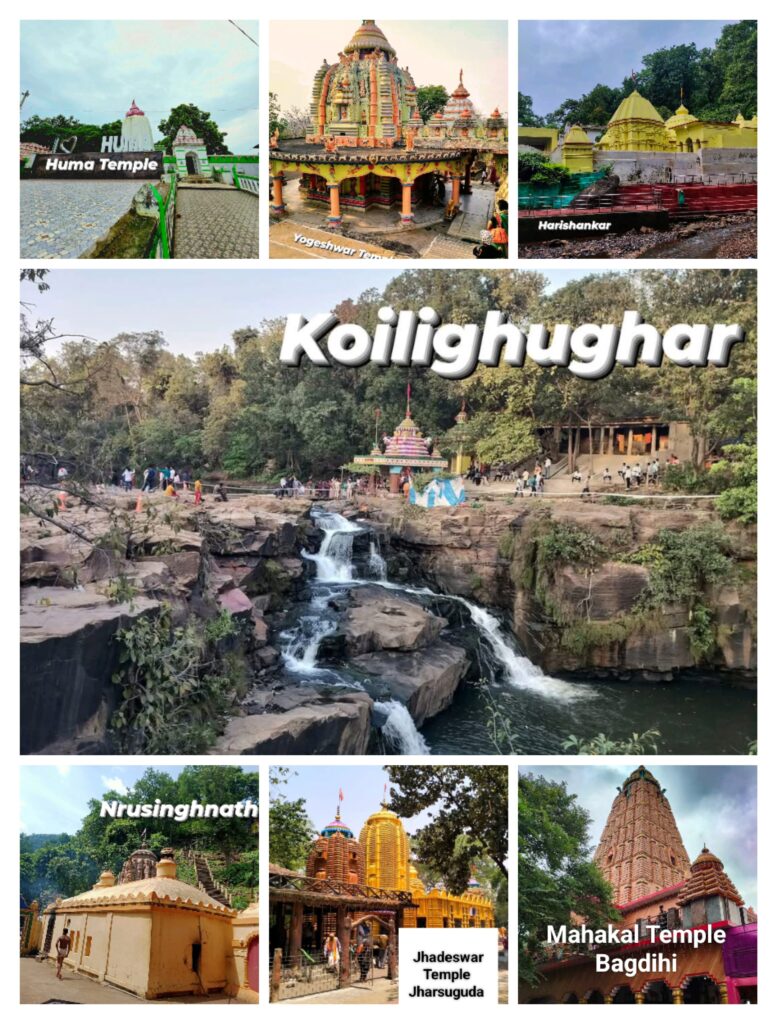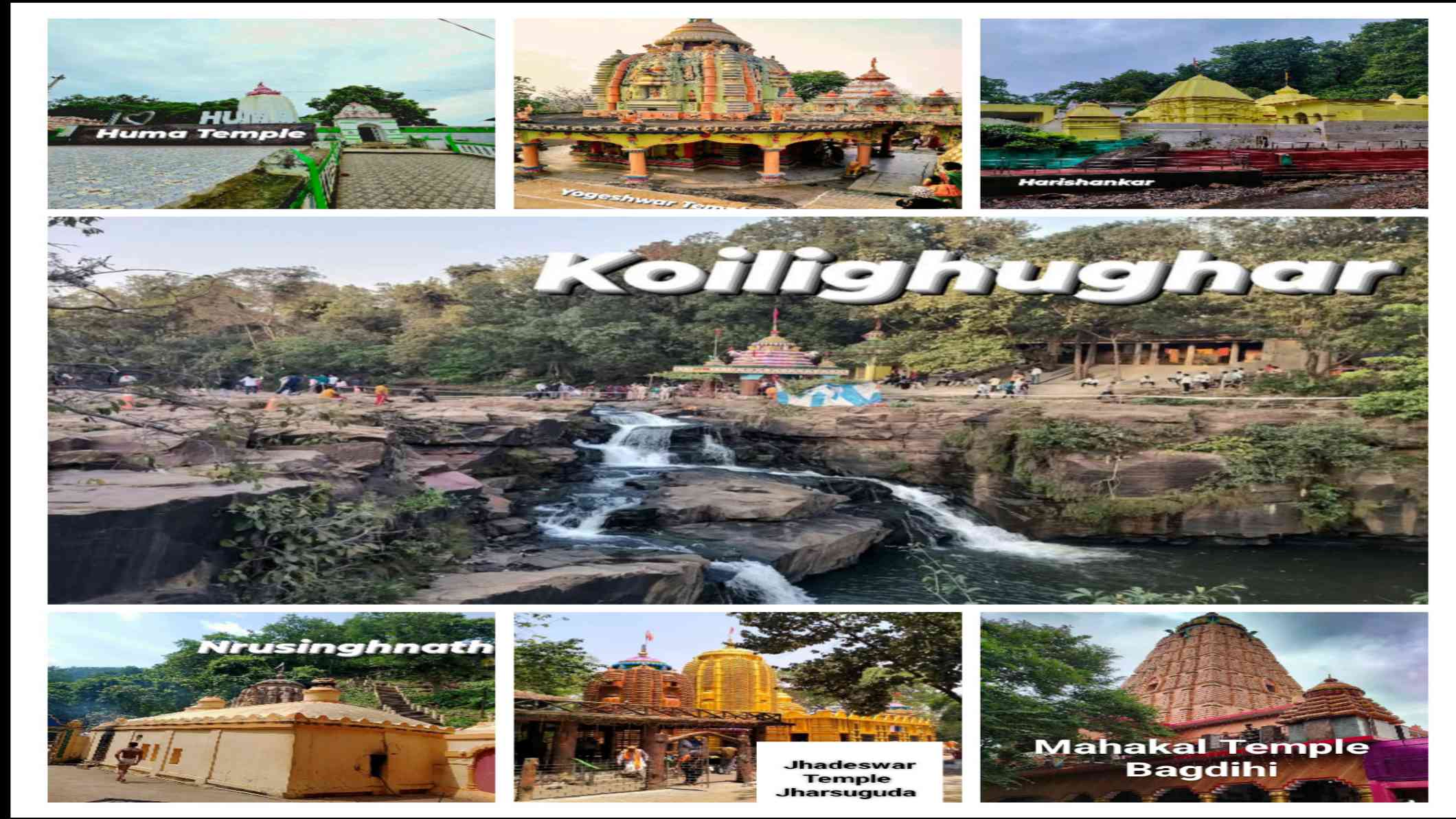
Top 10 Famous Shiva Temples of Western Odisha for Bol Bom Yatra
🔱 Introduction
Western Odisha is home to some of the most spiritually revered and naturally mesmerizing Shiva temples, perfect for the sacred Bol Bom Yatra during the holy month of Shravan. Pilgrims walk barefoot with kanwars, chanting “Bol Bom” while collecting holy water from rivers and offering it at famous Shiv temples. This article presents the Top 10 Shiva Temples in Western Odisha, selected for their religious significance, beauty, history, and pilgrimage value.
Each temple includes:
- Temple Description & Significance
- Historical Background
- Travel Route from District HQ & Local Landmarks
- Nearby Roads and Transportation
- Tabular Overview for Planning
🌟 1. Koilighughar Shiva Temple – Lakhanpur, Jharsuguda
🛕 Temple Description:
Located beside a scenic waterfall, this temple is nestled in a natural cave surrounded by forests. The Shiva Lingam lies submerged beneath the Koilighughar waterfall. An additional lingam called “Maheswarnath” is located inside a hidden cave and can only be seen by diving underwater.
📜 Historical Significance:
The temple is considered ancient, with deep tribal and Shaivite roots. It is believed to be a tapobhumi (meditation site) of sages.
🗺️ Route & Connectivity:
- From Jharsuguda: 50 km via Belpahar–Lakhanpur Road on NH49.
- From Govindpur Chowk: 7 km forest road leads to the temple.
- Connectivity: Good road up to koilighughar for all vehicles also.
🌟 2. Jhadeswar Temple (Shiva Temple )– Jharsuguda Town
🛕 Temple Description:
This temple hosts a Swayambhu Lingam (self-originated). It is the central temple for Bol Bom devotees in Jharsuguda town and sees massive footfall during Shravan.
📜 Historical Significance:
The temple has tribal and Shaivite links and is said to have existed for over 300 years. Locals believe it protects the town.
🗺️ Route & Connectivity:
- From Jharsuguda Station: 2 km via Purunabasti.
- From Beheramal Chowk: Autos available.
- Connectivity: Accessible by bike, car, and foot from any part of town.
🌟 3. Mahakal Temple, Bagdihi (Shiva temple)– Jharsuguda
🛕 Temple Description:
Located atop a small hill, the temple offers a beautiful view and peaceful surroundings. Devotees climb stairs with kanwars and offer water collected from nearby streams.
📜 Historical Significance:
Associated with tribal Shaivism and believed to be protected by forest spirits and Lord Shiva.
🗺️ Route & Connectivity:
- From Jharsuguda: 45 km via Bagdihi Road.
- From Bagdihi Railway Station: 2 km.
- Connectivity: Well connected by road, with shared autos available.
🌟 4. Vedvyas Temple (Shiva Temple)– Rourkela (Sundargarh)
🛕 Temple Description:
Situated at the Triveni Sangam (confluence of Sankha, Koel, and Saraswati), this spiritual spot houses temples dedicated to Lord Shiva and Sage Vedvyas.
📜 Historical Significance:
Said to be the birthplace of Vedvyas, the sage who composed the Mahabharata. The area is considered highly spiritual.
🗺️ Route & Connectivity:
- From Rourkela Station: 10 km via Panposh.
- From Ring Road: Direct road to temple complex.
- Connectivity: Autos, buses, and private vehicles easily accessible.
🌟 5. Huma Leaning Temple (Shiva Temple)– Sambalpur
🛕 Temple Description:
This temple is famous for its leaning structure, much like the Leaning Tower of Pisa. The Shiva Lingam here is placed on the bank of the Mahanadi River.
📜 Historical Significance:
Built in the 17th century by the King of Sambalpur. The leaning structure is said to be intentional or divinely influenced.
🗺️ Route & Connectivity:
- From Sambalpur: 26 km via Dhanakauda–Chiplima Road.
- From Chiplima Chowk: 6 km.
- Connectivity: Private vehicles, local buses, and shared autos available.
🌟 6. Nrusimhanath Temple (Shiva Temple)– Paikmal, Bargarh
🛕 Temple Description:
Located at the foothills of Gandhamardan mountain, this temple is surrounded by waterfalls, caves, and forest trails. Lord Shiva is worshipped along with Vishnu in this rare sacred combo.
📜 Historical Significance:
Connected to the Buddhist era, Gandhamardan hills were once home to Nalanda-style Buddhist universities.
🗺️ Route & Connectivity:
- From Bargarh Town: 110 km via Padampur–Paikmal.
- From Paikmal Chowk: 4 km forest road.
- Connectivity: Bus till Paikmal, shared jeeps to temple.
🌟 7. Harishankar Temple (Shiva Temple ) – Balangir
🛕 Temple Description:
Located on the other side of Gandhamardan Hills, the temple is dedicated to both Hari (Vishnu) and Shankar (Shiva). A beautiful waterfall flows beside it.
📜 Historical Significance:
Known for religious harmony and the presence of both Shaiva and Vaishnava deities.
🗺️ Route & Connectivity:
- From Balangir: 80 km via Patnagarh.
- From Harishankar Chowk: 2 km uphill.
- Connectivity: Buses and shared vehicles operate during Shravan.
🌟 8. Yogeshwar Temple (Shiva Temple ) – Patora, Nuapada
🛕 Temple Description:
Located near the banks of the Jonk River and Patora Dam, this temple is surrounded by hilly terrain and forests.
📜 Historical Significance:
Locals believe the Shiva Lingam emerged naturally. Tribal worship of Yogeshwar predates formal temples.
🗺️ Route & Connectivity:
- From Nuapada HQ: 20 km via Sinapali Road.
- From Patora Chowk: 2 km.
- Connectivity: Local jeeps and bike access.
🌟 9. Somnath Temple (Shiva Temple )– Titilagarh
🛕 Temple Description:
A lesser-known yet powerful Shiva shrine near Titilagarh. The temple is located near forested hills and a seasonal stream.
📜 Historical Significance:
Said to be founded by tribal kings and revered for healing powers of the Shiva Lingam.
🗺️ Route & Connectivity:
- From Titilagarh: 16 km via Muniguda Road.
- Connectivity: Limited buses; use local transport or personal vehicles.
10. Swapneswar Mahadev Temple (Shiva Temple )– Kalahandi
🛕 Temple Description:
Situated in Bhilamal, nestled in the serene foothills of the Eastern Ghats in Kalahandi district, the Swapneswar Mahadev Temple is a naturally formed Shiva Lingam believed to have appeared in a devotee’s dream—hence the name “Swapneswar” (Lord of Dreams). The temple is surrounded by dense forests and a small perennial stream that adds to the mystical ambiance.
📜 Historical Significance:
This temple has deep roots in tribal beliefs. It is said that local tribals have worshipped the Lingam since time immemorial, and later, a formal shrine was built. It is considered a spiritual destination where wishes come true if the devotee fasts during Shravan and Mahashivratri.
🛣️ Travel Route & Connectivity:
- From Bhawanipatna HQ: 95 km via Junagarh–Dharmagarh road
- Nearest Town/Chowk: Bhilamal
- From Sonepur Railway Station: 10 km
✅ Summary Table (for District-Wise Shiva Temples)
| Temple Name | District | Distance from HQ | Special Feature | Connectivity |
|---|---|---|---|---|
| Swapneswar Mahadev | Kalahandi | 95 km | Shiva of dreams, forest stream, tribal | Road (via Dharmagarh) |
| Kapileswar Temple | Balangir | 60 km | Cave shrine, meditation of Kapila Muni | Rail + Road (Titilagarh) |
| Dhabaleswar, Sonepur | Subarnapur | 12 km | White Lingam, riverbank temple | Road, Auto, Bus |
📋 Summary Table
| Temple Name | District | Distance from HQ | Special Feature | Connectivity |
|---|---|---|---|---|
| Koilighughar | Jharsuguda | 35 km | Waterfall + Underwater Lingam | Road + Forest Trail |
| Jhadeswar | Jharsuguda | 2 km | Swayambhu Lingam | Town Access |
| Mahakal, Bagdihi | Jharsuguda | 45 km | Hilltop Temple | Road/Auto |
| Vedvyas | Sundargarh | 10 km from Rourkela | River Sangam + Mahabharata Link | Easy Access |
| Huma Temple | Sambalpur | 26 km | Leaning Temple | Road/Auto |
| Nrusimhanath | Bargarh | 110 km | Waterfalls + Shiva-Vishnu Mix | Bus + Jeep |
| Harishankar | Balangir | 80 km | Twin Deities + Waterfall | Bus/Private |
| Yogeshwar, Patora | Nuapada | 20 km | Hill Base + Forest View | Jeep/Bike |
| Somnath, Titilagarh | Balangir | 16 km | Healing Lingam | Auto/Jeep |
| Guja Pahad | Jharsuguda | 25 km | Cave + Tribal Significance | Hill Road Access |
🗺️ Suggested Bol Bom Pilgrimage Route (5–7 Days)
Day 1: Jharsuguda → Koilighughar → Jhadeswar → Bagdihi
Day 2: Bagdihi → Vedvyas → Sambalpur → Huma
Day 3: Sambalpur → Bargarh → Nrusimhanath
Day 4: Nrusimhanath → Harishankar → Titilagarh → Somnath
Day 5: Titilagarh → Nuapada → Yogeshwar
Day 6: Return to Jharsuguda via Guja Pahad
🧳 Pilgrim Travel Tips
- Start early to avoid heat.
- Carry water, first-aid, and dry snacks.
- Foot pilgrims: plan rest at night halts in dharmasalas.
- Avoid plastic, help keep nature clean.
🕉️ Conclusion
These ten temples make Western Odisha a spiritually potent and scenic destination for Bol Bom pilgrims. Each site blends natural wonder, tribal traditions, ancient legends, and deep devotion. Whether you walk barefoot or drive temple to temple, the journey is bound to purify the heart and mind.
May Bholenath’s grace be with every pilgrim.
Har Har Mahadev! Bol Bom!!
Follow our Facebook page
Koilighughar- The Beauty of Nature
